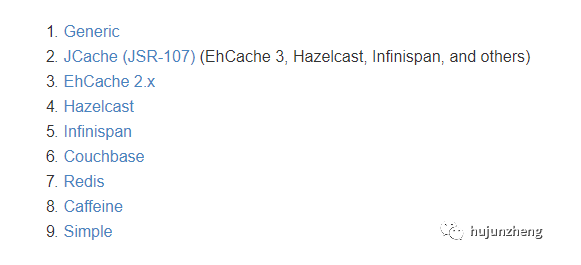springboot2.0 redis EnableCaching的配置和使用

一、前言
关于EnableCaching最简单使用,个人感觉只需提供一个CacheManager的一个实例就好了。springboot为我们提供了cache相关的自动配置。引入cache模块,如下。
二、maven依赖
<dependency>
<groupId>org.springframework.boot</groupId>
<artifactId>spring-boot-starter-cache</artifactId>
</dependency>
<dependency>
<groupId>org.springframework.boot</groupId>
<artifactId>spring-boot-starter-data-redis</artifactId>
</dependency>
<dependency>
<groupId>org.springframework.integration</groupId>
<artifactId>spring-integration-redis</artifactId>
</dependency>
<dependency>
<groupId>redis.clients</groupId>
<artifactId>jedis</artifactId>
</dependency>
三、缓存类型

本人也仅仅使用了redis、guava、ehcache。更多详情请参考 spring cache官方文档。
https://docs.spring.io/spring-boot/docs/current/reference/html/boot-features-caching.html
四、常用注解
@Cacheable 触发缓存填充
@CacheEvict 触发缓存驱逐
@CachePut 更新缓存而不会干扰方法执行
@Caching 重新组合要在方法上应用的多个缓存操作
@CacheConfig 在类级别共享一些常见的缓存相关设置
五、Spring Cache提供的SpEL上下文数据
下表直接摘自Spring官方文档:
|
名字
|
位置
|
描述
|
示例
|
|
methodName
|
root对象
|
当前被调用的方法名
|
#root.methodName
|
|
method
|
root对象
|
当前被调用的方法
|
#root.method.name
|
|
target
|
root对象
|
当前被调用的目标对象
|
#root.target
|
|
targetClass
|
root对象
|
当前被调用的目标对象类
|
#root.targetClass
|
|
args
|
root对象
|
当前被调用的方法的参数列表
|
#root.args[0]
|
|
caches
|
root对象
|
当前方法调用使用的缓存列表(如@Cacheable(value={"cache1", "cache2"})),则有两个cache
|
#root.caches[0].name
|
|
argument name
|
执行上下文
|
当前被调用的方法的参数,如findById(Long id),我们可以通过#id拿到参数
|
#user.id
|
|
result
|
执行上下文
|
方法执行后的返回值(仅当方法执行之后的判断有效,如‘unless’,'cache evict'的beforeInvocation=false)
|
#result
|
六、RedisCacheManager配置
基于jedis
@Configuration
@EnableCaching
public class RedisCacheConfig extends CachingConfigurerSupport {
@Autowired
private RedisProperties redisProperties;
@Bean
public JedisConnectionFactory jedisConnectionFactory() {
// 获取服务器数组(这里要相信自己的输入,所以没有考虑空指针问题)
String[] serverArray = redisProperties.getClusterNodes().split(",");
RedisClusterConfiguration redisClusterConfiguration = new
RedisClusterConfiguration(Arrays.asList(serverArray));
JedisPoolConfig jedisPoolConfig = new JedisPoolConfig();
// 最大空闲连接数, 默认8个
jedisPoolConfig.setMaxIdle(100);
// 最大连接数, 默认8个
jedisPoolConfig.setMaxTotal(500);
// 最小空闲连接数, 默认0
jedisPoolConfig.setMinIdle(0);
// 获取连接时的最大等待毫秒数(如果设置为阻塞时BlockWhenExhausted),如果超时就抛异常, 小于零:阻塞不确定的时间,
// 默认-1
jedisPoolConfig.setMaxWaitMillis(2000); // 设置2秒
// 对拿到的connection进行validateObject校验
jedisPoolConfig.setTestOnBorrow(true);
return new JedisConnectionFactory(redisClusterConfiguration
,jedisPoolConfig);
}
/** * 注入redis template * * @return */
@Bean
@Qualifier("redisTemplate")
public RedisTemplate redisTemplate(
JedisConnectionFactoryjedisConnectionFactory
, Jackson2JsonRedisSerializer jackson2JsonRedisSerializer) {
RedisTemplate template = new RedisTemplate();
template.setConnectionFactory(jedisConnectionFactory);
template.setKeySerializer(new JdkSerializationRedisSerializer());
template.setValueSerializer(jackson2JsonRedisSerializer);
template.afterPropertiesSet();
return template;
}
/** * redis cache manager * * @return */
@Bean
@Primary
public RedisCacheManager redisCacheManager(
JedisConnectionFactory jedisConnectionFactory
, ObjectProvider<List<RedisCacheConfigurationProvider>>
configurationProvider) {
Map<String, RedisCacheConfiguration> redisCacheConfigurationMap =
Maps.newHashMap();
List<RedisCacheConfigurationProvider> configurations
= configurationProvider.getIfAvailable();
if (!CollectionUtils.isEmpty(configurations)) {
for (RedisCacheConfigurationProvider configuration : configurations) {
redisCacheConfigurationMap.putAll(configuration.resolve());
}
}
RedisCacheManager cacheManager = RedisCacheManager.
RedisCacheManagerBuilder.fromConnectionFactory(jedisConnectionFactory)
.cacheDefaults(resovleRedisCacheConfiguration(Duration.
ofSeconds(300), JacksonHelper.genJavaType(Object.class)))
.withInitialCacheConfigurations(redisCacheConfigurationMap)
.build();
return cacheManager;
}
private static RedisCacheConfiguration resovleRedisCacheConfiguration(Duration duration, JavaType javaType) {
return RedisCacheConfiguration.defaultCacheConfig()
.serializeKeysWith(RedisSerializationContext
.SerializationPair
.fromSerializer(new StringRedisSerializer()))
.serializeValuesWith(RedisSerializationContext
.SerializationPair.fromSerializer(
new Jackson2JsonRedisSerializer<>(javaType)))
.entryTtl(duration);
}
/** * 配置一个序列器, 将对象序列化为字符串存储, 和将对象反序列化为对象 */
@Bean
public Jackson2JsonRedisSerializer jackson2JsonRedisSerializer() {
Jackson2JsonRedisSerializer jackson2JsonRedisSerializer = new Jackson2JsonRedisSerializer(Object.class);
ObjectMapper om = new ObjectMapper();
om.setVisibility(PropertyAccessor.ALL, JsonAutoDetect.Visibility.ANY);
om.enableDefaultTyping(ObjectMapper.DefaultTyping.NON_FINAL);
jackson2JsonRedisSerializer.setObjectMapper(om);
return jackson2JsonRedisSerializer;
}
public static abstract class RedisCacheConfigurationProvider {
// key = 缓存名称, value = 缓存时间 和 缓存类型
protected Map<String, Pair<Duration, JavaType>> configs;
protected abstract void initConfigs();
public Map<String, RedisCacheConfiguration> resolve() {
initConfigs();
Assert.notEmpty(configs, "RedisCacheConfigurationProvider 配置不能为空...");
Map<String, RedisCacheConfiguration> result = Maps.newHashMap();
configs.forEach((cacheName, pair) -> result.put(cacheName,
resovleRedisCacheConfiguration(pair.getKey(), pair.getValue())));
return result;
}
} }
基于Lettuce
@Configuration
@EnableCaching
public class RedisCacheConfig extends CachingConfigurerSupport { @Autowired
private RedisProperties redisProperties;
@Bean
public LettuceConnectionFactory lettuceConnectionFactory() {
String[] serverArray = redisProperties.getClusterNodes().split(",");// 获取服务器数组(这里要相信自己的输入,所以没有考虑空指针问题)
RedisClusterConfiguration redisClusterConfiguration = new RedisClusterConfiguration(Arrays.asList(serverArray));
GenericObjectPoolConfig poolConfig = new GenericObjectPoolConfig();
// 最大空闲连接数, 默认8个
poolConfig.setMaxIdle(100);
// 最大连接数, 默认8个
poolConfig.setMaxTotal(500);
// 最小空闲连接数, 默认0
poolConfig.setMinIdle(0);
LettuceClientConfiguration lettuceClientConfiguration = LettucePoolingClientConfiguration.builder()
.commandTimeout(Duration.ofSeconds(15))
.poolConfig(poolConfig)
.shutdownTimeout(Duration.ZERO)
.build();
return new LettuceConnectionFactory(redisClusterConfiguration, lettuceClientConfiguration);
}
/** * 注入redis template * * @return */
@Bean
@Qualifier("redisTemplate")
public RedisTemplate redisTemplate(LettuceConnectionFactory lettuceConnectionFactory, Jackson2JsonRedisSerializer jackson2JsonRedisSerializer) {
RedisTemplate template = new RedisTemplate();
template.setConnectionFactory(lettuceConnectionFactory);
template.setKeySerializer(new JdkSerializationRedisSerializer());
template.setValueSerializer(jackson2JsonRedisSerializer);
template.afterPropertiesSet();
return template;
}
/** * redis cache manager * * @return */
@Bean
@Primary
public RedisCacheManager redisCacheManager(LettuceConnectionFactory lettuceConnectionFactory, ObjectProvider<List<RedisCacheConfigurationProvider>> configurationProvider) {
Map<String, RedisCacheConfiguration> redisCacheConfigurationMap = Maps.newHashMap();
List<RedisCacheConfigurationProvider> configurations = configurationProvider.getIfAvailable();
if (!CollectionUtils.isEmpty(configurations)) {
for (RedisCacheConfigurationProvider configuration : configurations) {
redisCacheConfigurationMap.putAll(configuration.resolve());
}
}
RedisCacheManager cacheManager = RedisCacheManager.RedisCacheManagerBuilder.fromConnectionFactory(lettuceConnectionFactory)
.cacheDefaults(resovleRedisCacheConfiguration(Duration.ofSeconds(300), JacksonHelper.genJavaType(Object.class)))
.withInitialCacheConfigurations(redisCacheConfigurationMap)
.build();
return cacheManager;
}
private static RedisCacheConfiguration resovleRedisCacheConfiguration(Duration duration, JavaType javaType) {
return RedisCacheConfiguration.defaultCacheConfig()
.serializeKeysWith(RedisSerializationContext.SerializationPair.fromSerializer(new StringRedisSerializer()))
.serializeValuesWith(RedisSerializationContext.SerializationPair.fromSerializer(new Jackson2JsonRedisSerializer<>(javaType)))
.entryTtl(duration);
}
@Bean
public RedisLockRegistry redisLockRegistry(LettuceConnectionFactory lettuceConnectionFactory) {
return new RedisLockRegistry(lettuceConnectionFactory, "recharge-plateform", 60000 * 20);
}
/** * 配置一个序列器, 将对象序列化为字符串存储, 和将对象反序列化为对象 */
@Bean
public Jackson2JsonRedisSerializer jackson2JsonRedisSerializer() {
Jackson2JsonRedisSerializer jackson2JsonRedisSerializer = new Jackson2JsonRedisSerializer(Object.class);
ObjectMapper om = new ObjectMapper();
om.setVisibility(PropertyAccessor.ALL, JsonAutoDetect.Visibility.ANY);
om.enableDefaultTyping(ObjectMapper.DefaultTyping.NON_FINAL);
jackson2JsonRedisSerializer.setObjectMapper(om);
return jackson2JsonRedisSerializer;
}
public static abstract class RedisCacheConfigurationProvider {
// key = 缓存名称, value = 缓存时间 和 缓存类型
protected Map<String, Pair<Duration, JavaType>> configs;
protected abstract void initConfigs();
public Map<String, RedisCacheConfiguration> resolve() {
initConfigs();
Assert.notEmpty(configs, "RedisCacheConfigurationProvider 配置不能为空...");
Map<String, RedisCacheConfiguration> result = Maps.newHashMap();
configs.forEach((cacheName, pair) -> result.put(cacheName, resovleRedisCacheConfiguration(pair.getKey(), pair.getValue())));
return result;
}
} }
Jedis和Lettuce比较
Jedis 是直连模式,在多个线程间共享一个 Jedis 实例时是线程不安全的,如果想要在多线程环境下使用 Jedis,需要使用连接池,
每个线程都去拿自己的 Jedis 实例,当连接数量增多时,物理连接成本就较高了。
Lettuce的连接是基于Netty的,连接实例可以在多个线程间共享,
所以,一个多线程的应用可以使用同一个连接实例,而不用担心并发线程的数量。当然这个也是可伸缩的设计,一个连接实例不够的情况也可以按需增加连接实例。通过异步的方式可以让我们更好的利用系统资源,而不用浪费线程等待网络或磁盘I/O。
只在基于Lettuce的配置中,加入了RedisLockRegistry对应bean的配置,由于在集群的模式下,基于Jedis的配置下,通过RedisLockRegistry 获取分布式锁的时候报错:
EvalSha is not supported in cluster environment
具体的解决方案就是切换至基于Lettuce的配置,请参考
https://stackoverflow.com/questions/47092475/spring-boot-redistemplate-execute-sc
RedisCacheConfigurationProvider 作用为不同的cache提供特定的缓存时间以及key、value序列化和反序列化的方式。具体使用方式如下。
@Component
public class CouponRedisCacheConfigurationProvider extends RedisCacheConfig.RedisCacheConfigurationProvider {
@Override
protected void initConfigs() {
this.configs = Maps.newHashMap();
this.configs.put(CouponConstants.COUPON_ALL_CACHE, new Pair<>(Duration.ofHours(1), JacksonHelper.genMapType(HashMap.class, Integer.class, Coupon.class)));
this.configs.put(CouponConstants.COUPON_GOOD_CACHE, new Pair<>(Duration.ofHours(1), JacksonHelper.genCollectionType(List.class, String.class)));
this.configs.put(CouponConstants.COUPON_HANDLE_TELEPHONE_STATUS_CACHE, new Pair<>(Duration.ofMinutes(10), JacksonHelper.genCollectionType(List.class, CouponHandle.class)));
this.configs.put(CouponConstants.COUPON_HANDLE_TELEPHONE_GOOD_CACHE, new Pair<>(Duration.ofMinutes(10), JacksonHelper.genCollectionType(List.class, CouponHandle.class)));
}
}
JacksonHelper 作用是根据不同的类型的对象获取对应的JavaType对象,在构造RedisTempalte序列化和反序列化器Jackson2JsonRedisSerializer对象需要。具体代码如下。
public class JacksonHelper {
private static Logger LOGGER = LoggerFactory.getLogger(JacksonHelper.class);
private static final SimpleModule module = initModule();
private static final ObjectMapper objectMapper;
private static final ObjectMapper prettyMapper;
public JacksonHelper() {
}
private static SimpleModule initModule() {
return (new SimpleModule()).addSerializer(BigDecimal.class, new BigDecimalSerializer())
.addSerializer(LocalTime.class, new LocalTimeSerializer())
.addDeserializer(LocalTime.class, new LocalTimeDeserializer())
.addSerializer(LocalDate.class, new LocalDateSerializer())
.addDeserializer(LocalDate.class, new LocalDateDeserializer())
.addSerializer(LocalDateTime.class, new LocalDateTimeSerializer())
.addDeserializer(LocalDateTime.class, new LocalDateTimeDeserializer())
.addSerializer(Date.class, new DateSerializer())
.addDeserializer(Date.class, new DateDeserializer());
}
public static JavaType genJavaType(TypeReference<?> typeReference) {
return getObjectMapper().getTypeFactory().constructType(typeReference.getType());
}
public static JavaType genJavaType(Class<?> clazz) {
return getObjectMapper().getTypeFactory().constructType(clazz);
}
public static JavaType genCollectionType(Class<? extends Collection> collectionClazz, Class<?> javaClazz) {
return getObjectMapper().getTypeFactory().constructCollectionType(collectionClazz, javaClazz);
}
public static JavaType genMapType(Class<? extends Map> mapClazz, Class<?> keyClass, Class<?> valueClazz) {
return getObjectMapper().getTypeFactory().constructMapType(mapClazz, keyClass, valueClazz);
}
public static ObjectMapper getObjectMapper() {
return objectMapper;
}
public static ObjectMapper getPrettyMapper() {
return prettyMapper;
}
static {
objectMapper = (new ObjectMapper()).registerModule(module).configure(DeserializationFeature.FAIL_ON_UNKNOWN_PROPERTIES, false).configure(DeserializationFeature.READ_UNKNOWN_ENUM_VALUES_AS_NULL, true).configure(SerializationFeature.FAIL_ON_EMPTY_BEANS, false);
prettyMapper = objectMapper.copy().configure(SerializationFeature.INDENT_OUTPUT, true);
}
}
class LocalDateDeserializer extends JsonDeserializer<LocalDate> {
public LocalDateDeserializer() {
}
public LocalDate deserialize(JsonParser jp, DeserializationContext ctxt) throws IOException {
String dateString = ((JsonNode) jp.getCodec().readTree(jp)).asText();
return LocalDate.parse(dateString, DateTimeFormatter.ISO_LOCAL_DATE);
}
}
class DateDeserializer extends JsonDeserializer<Date> {
public DateDeserializer() {
}
public Date deserialize(JsonParser jp, DeserializationContext ctxt) throws IOException {
String dateTimeStr = ((JsonNode) jp.getCodec().readTree(jp)).asText();
SimpleDateFormat sdf = new SimpleDateFormat(CouponConstants.DATE_TIME_FORMATER);
ParsePosition pos = new ParsePosition(0);
return sdf.parse(dateTimeStr, pos);
}
}
class LocalDateTimeDeserializer extends JsonDeserializer<LocalDateTime> {
public LocalDateTimeDeserializer() {
}
public LocalDateTime deserialize(JsonParser jp, DeserializationContext ctxt) throws IOException {
String dateTimeStr = ((JsonNode) jp.getCodec().readTree(jp)).asText();
return LocalDateTime.parse(dateTimeStr, DateTimeFormatter.ISO_LOCAL_DATE_TIME);
}
}
class LocalTimeDeserializer extends JsonDeserializer<LocalTime> {
public LocalTimeDeserializer() {
}
public LocalTime deserialize(JsonParser jp, DeserializationContext ctxt) throws IOException {
String dateString = ((JsonNode) jp.getCodec().readTree(jp)).asText();
return LocalTime.parse(dateString, DateTimeFormatter.ISO_LOCAL_TIME);
}
}
class BigDecimalSerializer extends JsonSerializer<BigDecimal> {
public BigDecimalSerializer() {
}
public void serialize(BigDecimal value, JsonGenerator jgen, SerializerProvider provider) throws IOException {
jgen.writeString(value.toString());
}
}
class LocalDateSerializer extends JsonSerializer<LocalDate> {
public LocalDateSerializer() {
}
public void serialize(LocalDate value, JsonGenerator jgen, SerializerProvider provider) throws IOException {
jgen.writeString(DateTimeFormatter.ISO_LOCAL_DATE.format(value));
}
}
class LocalDateTimeSerializer extends JsonSerializer<LocalDateTime> {
public LocalDateTimeSerializer() {
}
public void serialize(LocalDateTime value, JsonGenerator jgen, SerializerProvider provider) throws IOException {
jgen.writeString(DateTimeFormatter.ISO_LOCAL_DATE_TIME.format(value));
}
}
class DateSerializer extends JsonSerializer<Date> {
public DateSerializer() {
}
public void serialize(Date value, JsonGenerator jgen, SerializerProvider provider) throws IOException {
SimpleDateFormat sdf = new SimpleDateFormat(CouponConstants.DATE_TIME_FORMATER);
jgen.writeString(sdf.format(value));
}
}
class LocalTimeSerializer extends JsonSerializer<LocalTime> {
public LocalTimeSerializer() {
}
public void serialize(LocalTime value, JsonGenerator jgen, SerializerProvider provider) throws IOException {
jgen.writeString(DateTimeFormatter.ISO_LOCAL_TIME.format(value));
}
}
业务代码
@Component
public class ServiceImpl { @Override
@CacheEvict(cacheNames = CouponConstants.COUPON_HANDLE_TELEPHONE_STATUS_CACHE, key = "#telephone+'#'+#status", beforeInvocation = true)
public void evictCouponHandles(String telephone, Integer status) { } @Override
@Cacheable(cacheNames = CouponConstants.COUPON_HANDLE_TELEPHONE_STATUS_CACHE, key = "#telephone+'#'+#status", sync = true)
public List<CouponHandle> searchCouponHandles(String telephone, Integer status) {
} }
不同的缓存对应不同的存储类型,不同的存储类型对应着不同的序列化和反序列化器,这就保证了再调用注有@Cacheable注解的代码时获取到的对象不会发生类型转换错误。关于设置不同的cache下过期时间以及序列化和反序列器,请参考下面更直接明了的例子。
@Configuration
public class RedisCacheConfig {
@Bean
public KeyGenerator simpleKeyGenerator() {
return (o, method, objects) -> {
StringBuilder stringBuilder = new StringBuilder();
stringBuilder.append(o.getClass().getSimpleName());
stringBuilder.append(".");
stringBuilder.append(method.getName());
stringBuilder.append("[");
for (Object obj : objects) {
stringBuilder.append(obj.toString());
}
stringBuilder.append("]");
return stringBuilder.toString();
};
}
@Bean
public CacheManager cacheManager(RedisConnectionFactory redisConnectionFactory) {
return new RedisCacheManager(
RedisCacheWriter.nonLockingRedisCacheWriter(redisConnectionFactory),
this.getRedisCacheConfigurationWithTtl(600), // 默认策略,未配置的 cache 会使用这个
this.getRedisCacheConfigurationMap() // 指定 cache 策略
);
}
private Map<String, RedisCacheConfiguration> getRedisCacheConfigurationMap() {
Map<String, RedisCacheConfiguration> redisCacheConfigurationMap = new HashMap<>();
redisCacheConfigurationMap.put("UserInfoList", this.getRedisCacheConfigurationWithTtl(3000));
redisCacheConfigurationMap.put("UserInfoListAnother", this.getRedisCacheConfigurationWithTtl(18000));
return redisCacheConfigurationMap;
}
private RedisCacheConfiguration getRedisCacheConfigurationWithTtl(Integer seconds) {
Jackson2JsonRedisSerializer<Object> jackson2JsonRedisSerializer = new Jackson2JsonRedisSerializer<>(Object.class);
ObjectMapper om = new ObjectMapper();
om.setVisibility(PropertyAccessor.ALL, JsonAutoDetect.Visibility.ANY);
om.enableDefaultTyping(ObjectMapper.DefaultTyping.NON_FINAL);
jackson2JsonRedisSerializer.setObjectMapper(om);
RedisCacheConfiguration redisCacheConfiguration = RedisCacheConfiguration.defaultCacheConfig();
redisCacheConfiguration = redisCacheConfiguration.serializeValuesWith(
RedisSerializationContext
.SerializationPair
.fromSerializer(jackson2JsonRedisSerializer)
).entryTtl(Duration.ofSeconds(seconds));
return redisCacheConfiguration;
}
}
@Cacheable(value = "UserInfoList", keyGenerator = "simpleKeyGenerator") // 3000秒
@Cacheable(value = "UserInfoListAnother", keyGenerator = "simpleKeyGenerator") // 18000秒
@Cacheable(value = "DefaultKeyTest", keyGenerator = "simpleKeyGenerator") // 600秒,未指定的cache,使用默认策略
springboot2.0 redis EnableCaching的配置和使用的更多相关文章
- springBoot2.0+redis+fastJson+自定义注解实现方法上添加过期时间
springBoot2.0集成redis实例 一.首先引入项目依赖的maven jar包,主要包括 spring-boot-starter-data-redis包,这个再springBoot2.0之前 ...
- springboot2.0+redis实现消息队列+redis做缓存+mysql
本博客仅供参考,本人实现没有问题. 1.环境 先安装redis.mysql 2.springboot2.0的项目搭建(请自行完成),本人是maven项目,因此只需配置,获取相应的jar包,配置贴出. ...
- SpringBoot2.0之六 多环境配置
开发过程中面对不同的环境,例如数据库.redis服务器等的不同,可能会面临一直需要修改配置的麻烦中,在以前的项目中,曾通过Tomcat的配置来实现,有的项目甚至需要手动修改相关配置,这种方式费时费力, ...
- SpringBoot2.0之八 多数据源配置
在开发的过程中我们可能都会遇到对接公司其他系统等需求,对于外部的系统可以采用接口对接的方式,对于一个公司开发的两个系统,并且知道相关数据库结构的情况下,就可以考虑使用多数据源来解决这个问题.Spri ...
- SpringBoot2.0 redis生成组建和读写配置文件
@Component 生成组建 @ConfigurationProperties(prefix="redis") 读写redis配置文件 application.propertie ...
- springboot2.0和Druid整合配置数据源
1. idea使用spring 初始化工具初始化springboot项目(要选中web) 下一步,下一步 2. 在pom.xml中,引入Druid连接池依赖: <dependency> & ...
- IntelliJ IDEA 2017版 spring-boot2.0.4的yml配置使用
一.必须配置字端两个 server: port: 8080 servlet: context-path: /demo 二.两种mvc转换springboot,一种是注解,一种就是.yml或proper ...
- IntellJ IDEA2017 springboot2.0.2中读取配置
IDEA 路径 src\main\resources\application.properties 配置文件名称为 application.properties 默认的位置在classpath根目录下 ...
- springboot2.0最精简的配置yml
https://blog.csdn.net/yu_hongrun/article/details/81708762
随机推荐
- 基于 Confluence 6 数据中心的 SAML 单点登录设置 SSL/TLS
请确定 SAML 授权是安全和私有的,你需要在你的应用程序中设置SSL/TLS. 请参考in the application. See Running Confluence Over SSL or H ...
- LeetCode(125):验证回文串
Easy! 题目描述: 给定一个字符串,验证它是否是回文串,只考虑字母和数字字符,可以忽略字母的大小写. 说明:本题中,我们将空字符串定义为有效的回文串. 示例 1: 输入: "A man, ...
- Nginx详解二十一:Nginx深度学习篇之配置苹果要求的openssl后台HTTPS服务
配置苹果要求的证书: 1.服务器所有的连接使用TLS1.2以上的版本(openssl 1.0.2) 2.HTTPS证书必须使用SHA256以上哈希算法签名 3.HTTPS证书必须使用RSA2048位或 ...
- 微信如何获取unionid 并且打通微信公众号和小程序
准备 1.微信公众号 2.微信小程序 3.微信开发平台帐号 没有在开发平台绑定的小程序和公众号是没法获取unionid的 只需要在开发平台绑定小程序和公众号,便可以获取unionid 其中对于小程序和 ...
- 论文阅读笔记三十七:Grid R-CNN(CVPR2018)
论文源址:https://arxiv.org/abs/1811.12030 开源代码:未公开 摘要 本文提出了目标检测网络Grid R-CNN,其基于网格定位机制实现准确的目标检测.传统方法主要基于回 ...
- ActiveSync的Settings命令
在[MS-ASCMD]中,Settings命令的功能这样定义的: The Settings command also sends device information to ...
- servlet设置cookie
Cookie cookie =new Cookie("user","黄花菜");//实例化一个Cookie对象 cookie.setMaxAge(7*24*60 ...
- mybatis 遍历map;
mybatis 遍历map; 参考http://blog.csdn.net/hj7jay/article/details/78652050 ps: ${m[key]}这是显示 打印的key读value ...
- views.py视图函
views.py视图函数来自 urls 的映射关系 常用所需模块 from django.shortcuts import render # ****** 渲染 render 跳转到指定的 url.h ...
- SQL查询数据并插入新表
SQL查询数据并插入新表 --如果接受数据导入的表已经存在 insert into 表 select * from tablename --如果导入数据并生成表 select * into 表 fro ...
